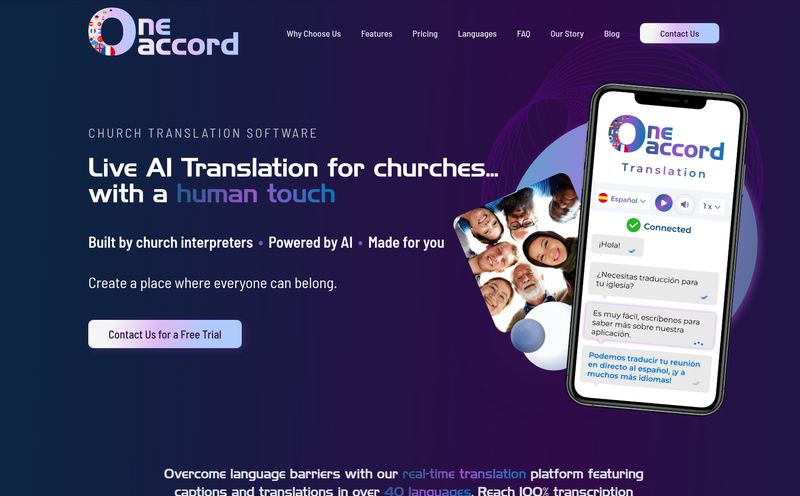If you're a healthcare provider, there's a good chance you spend more quality time with your EMR than with your family on some days. The endless clicking, typing, and templating... it's the soul-sucking dementor of modern medicine. We got into this field to connect with and care for people, not to become high-priced data entry clerks. I've seen physician burnout firsthand, and I swear, the paperwork is half the battle.
So, whenever a new tool pops up promising to slay this dragon, my ears perk up. I’m naturally skeptical, of course. We've been promised tech utopia before. But I've been hearing some chatter about a platform called Scribe Medix, and the claims they’re making are… well, they're big. A 90% reduction in documentation tasks? Sixty-second chart closures? I had to take a look for myself.

Visit Scribe Medix
So, What Exactly is Scribe Medix?
At its core, Scribe Medix is an AI-powered medical scribe. Think of it as a hyper-efficient medical student who never needs a coffee break and has perfect recall. It’s designed to listen in on your patient conversations (ambiently, they call it) and intelligently pull out the medically relevant bits to create accurate, structured notes. No more trying to type and maintain eye contact at the same time, which always makes me feel like a malfunctioning robot.
It seems to break down into two main offerings: ConvoScribe, which does that ambient listening thing, and Virtual Scribe, for more flexible, real-time documentation support. The goal is simple: let the tech handle the notes so you can handle the patient.
The Real-World Problem It’s Trying to Solve
The struggle with clinical notes isn't just an annoyance; it’s a systemic issue. It chips away at the doctor-patient relationship. Every second spent staring at a screen is a second not spent observing a patient's non-verbal cues or building rapport. Dr. Omer Iqbal of IM Clinic, quoted on their site, puts it perfectly:
"Using Scribe Medix for my documentation in the office has been a game-changer. It has allowed me to redirect my focus from the computer to the patient. My charting is done instead of being a burden on me. The notes are very detailed, and I am able to see more patients and finish earlier, which has been a tremendous benefit."
That hits home. It’s not just about efficiency, it's about reclaiming the very essence of our job. Finishing earlier? Seeing more patients without feeling rushed? That’s not just a quality of life improvement; it’s a practice-viability improvement.
How Scribe Medix Aims to Change Your Workflow
Okay, so how does this magic actually happen? From what I've gathered, it’s a combination of a few clever features that work together to lift the documentation burden.
Giving You Back Your Most Valuable Asset: Time
The headline stats are a 90% reduction in documentation tasks and 60-second chart closure time. If that's even half-true for the average practice, it's a monumental shift. Think about what you could do with all those reclaimed hours. More patients? More research? Leaving the office on time for once? It’s a compelling thought. It’s the difference between charting until 9 PM and actually making it to your kid's soccer game.
Focusing on the Human in the Room
This is the part that excites me most. The platform’s “Engagement” feature is all about letting you have a natural conversation. You talk, the AI listens and curates. No more awkward pauses while you frantically search for the right dropdown menu. You can just be a doctor again. This subtle shift from screen-centric to patient-centric care can't be overstated. It’s better for you and it’s a thousand times better for the patient.
Boosting Accuracy and Simplifying Billing
Let's talk money and compliance. Scribe Medix also generates ICD-10 billing code suggestions. This is huge. It not only saves time but can also reduce costly coding errors and claim denials. Getting the notes right is one thing, but getting the billing right is what keeps the lights on. The fact that it integrates this into the workflow is a really smart move, showing they understand the business side of running a practice.
The Plans and Pricing Breakdown
Alright, let's get down to brass tacks. What does it cost? Scribe Medix has a tiered approach, which I appreciate. Not every practice has the same needs or budget.
| Plan | Price | Best For |
|---|---|---|
| Core | Free for 1 Month (20 credits) | Trying it out, low-volume users. |
| Standard | $99/mo (paid annually) or $110/mo (paid monthly) | Established practices needing unlimited dictations. |
| Premium | $139/mo (paid annually) or $149/mo (paid monthly) | Large practices or anyone needing EMR integration (specifically athenahealth). |
The Core plan is basically a generous free trial. It's a no-brainer to sign up and see if the workflow even fits your style. The Standard plan seems like the sweet spot for most independent or small practices, offering unlimited use. But the Premium plan is where the real power lies for many, and it all comes down to one major feature...
The Holy Grail: EMR Integration with athenahealth
This is the big one. The Premium plan's integration with athenahealth is the feature that separates Scribe Medix from a simple transcription tool. A scribe that doesn't talk to your EMR is only half a solution. You still have to copy and paste, which introduces friction and room for error.
By plugging directly into a major EMR like Athenahealth, Scribe Medix can push its structured notes, SOAPs, and codes right where they need to go. This closes the loop and automates the entire process, not just part of it. If you're running on athenahealth, the Premium plan isn't just a luxury; it's probably the only one that makes sense for truly transforming your workflow.
My Honest Take: The Good and The... Considerations
So, is it perfect? No tool is. On the plus side, the time savings, improved accuracy, and ability to focus on patients are massive wins. It genuinely seems designed by people who understand the clinical grind.
On the other hand, it's not free (after the trial). It's an investment, and you have to calculate if the time you save is worth the monthly fee. For most overworked docs, I suspect the math will work out favorably. There's also likely a bit of a learning curve to get it set up and trust the AI completely. And, the all-important EMR integration is locked behind the priciest plan, which is a common but sometimes frustrating SaaS model.
Frequently Asked Questions about Scribe Medix
- Is Scribe Medix HIPAA compliant?
- Yes, according to their feature comparison chart, they use HIPAA compliant technologies across all plans, including end-to-end encryption and data anonymization. This is obviously non-negotiable.
- What EMRs does it integrate with?
- Right now, the explicit integration mentioned is with athenahealth, and it's only available on the Premium plan. You would need to inquire with them about timelines for other EMRs.
- Can I really try it for free?
- Yes, the Core plan is free for your first month and gives you 20 free credits to test out the real-time conversation scribing, templates, and ICD-10 recommendations.
- What's the difference between the Standard and Premium plans?
- The main difference is EMR integration. The Premium plan includes the integration with athenahealth and offers VIP support. The Standard plan has unlimited dictations but lacks that direct EMR connection.
- Will this work for my specialty?
- The tool is built with customizable templates, which suggests it can be adapted for various specialities. The best way to know for sure is to use the free trial to see how it handles the terminology and nuance of your specific field.
- Is there a mobile app?
- Yes, the homepage shows it's available through web browsers, a dedicated app (with QR codes for both Apple and Google Play stores), and on Windows PCs and Macs, offering a lot of flexibility.
Final Thoughts: A Step in the Right Direction?
Look, the war against administrative bloat in healthcare is going to be a long one. There's no single silver bullet. But I have to say, tools like Scribe Medix give me a bit of hope. It’s a solution that directly targets one of the biggest sources of physician dissatisfaction. By leveraging AI to handle the tedious work, it promises to give us back the time and mental space to do what we signed up for: practicing the art of medicine.
Is it right for you? Only you can decide. But with a free trial on the table, I'd say it’s definitely worth a look. Anything that helps us put down the keyboard and look our patients in the eye is a win in my book.



